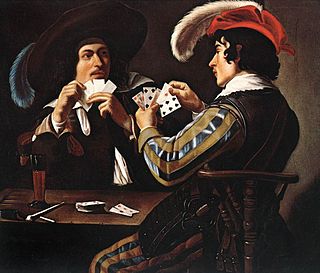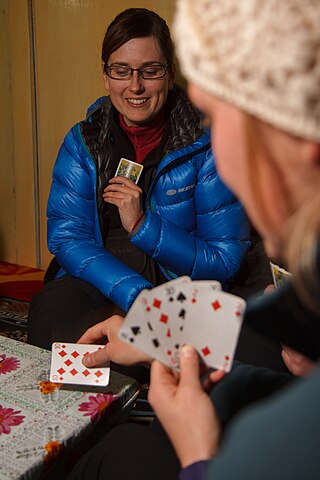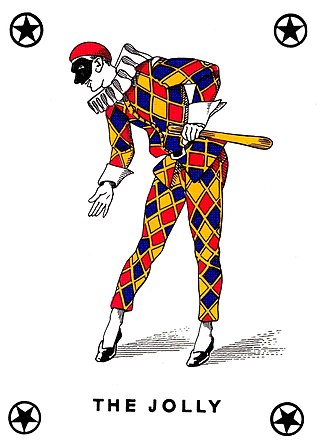
A card game is any game using playing cards as the primary device with which the game is played, be they traditional or game-specific. Countless card games exist, including families of related games. A small number of card games played with traditional decks have formally standardized rules with international tournaments being held, but most are folk games whose rules may vary by region, culture, location or from circle to circle.

Pinochle, also called pinocle or penuchle, is a trick-taking, Ace-Ten card game typically for two to four players and played with a 48-card deck. It is derived from the card game bezique; players score points by trick-taking and also by forming combinations of characters into melds. It is thus considered part of a "trick-and-meld" category which also includes the game belote. Each hand is played in three phases: bidding, melds, and tricks. The standard game today is called "partnership auction pinochle".

Sheepshead is an American trick-taking card game derived from Bavaria's national card game, Schafkopf, hence it is sometimes called American Schafkopf. Sheepshead is most commonly played by five players, but variants exist to allow for two to eight players. There are also many other variants to the game rules, and many slang terms used with the game.

President is a shedding card game for three or more, in which the players race to get rid of all of the cards in their hands in order to become "president" in the following round. It is a Westernized version of Chinese climbing card games such as Zheng Shangyou, and the Japanese Daifugō.

The Joker is a playing card found in most modern French-suited card decks, as an addition to the standard four suits. From the second half of the 20th century, they have also been found in Spanish- and Italian-suited decks, excluding stripped decks.
A trick deck is a deck of playing cards that has been altered in some way to allow magicians to perform certain card tricks where sleight of hand would be too difficult or impractical.

Cardistry is the performance art of card flourishing. Unlike card magic, cardistry is meant to be visually impressive and appear very hard to execute.

Briscola is one of Italy's most popular games, together with Scopa and Tressette (Tresette). A little-changed descendant of Brusquembille, the ancestor of Briscan and Bezique, Briscola is a Mediterranean trick-taking, Ace-Ten card game for two to six players played with a standard Italian 40-card deck. The game can also be played with a modern Anglo-French deck, without the eight, nine and ten cards. With three or six players, twos are removed from the deck to ensure the number of cards in the deck is a multiple of the number of players; a single two for three players and all four twos for six players. The four and six-player versions of the game are played as a partnership game of two teams, with players seated such that every player is adjacent to two opponents.

Truco, a variant of Truc, is a trick-taking card game originally from Valencia and the Balearic Islands, popular in South America and Italy. It is usually played using a Spanish deck. Two people may play, or two teams of two or three players each.

Out of This World is a card trick created by magician Paul Curry in 1942, in which an audience member is asked to sort a deck into piles of red and black cards, without looking at the faces. Many performers have devised their own variations of this trick. It is often billed as "the trick that fooled Winston Churchill" due to a story describing how it was performed for him during World War II. The method behind the trick is simple and essentially self-working, and can be enhanced by the presentation of the performer and the use of other principles of magic.

Alexander Herrmann was a French magician, better known as Herrmann the Great. He was married to magician Adelaide Herrmann, known as the Queen of Magic.

Card throwing is the art of throwing standard playing cards with great accuracy or force. It is performed both as part of stage magic shows and as a competitive physical feat among magicians, with official records existing for longest distance thrown, fastest speed, highest throw, greatest accuracy, and the greatest number of cards in one minute.
This is a glossary of conjuring terms used by magicians.
Spelling Bee may refer to one of several card tricks that revolve around the spelling of card types, audience member names, or words suggested by the audience. Many make use of decks prepared in advance in order to provide the illusion of spelling card names in a particular sequence. Jean Hugard's Encyclopedia of Card Tricks lists a number of such spelling-based tricks, many of which are considered to be self-working.

Switch is a shedding-type card game for two or more players that is popular in the United Kingdom, Ireland and as alternative incarnations in other regions. The sole aim of Switch is to discard all of the cards in one's hand; the first player to play their final card, and ergo have no cards left, wins the game. Switch is very similar to the games UNO, Flaps and Mau Mau, both belonging to the larger Crazy Eights or Shedding family of card games.

Penn & Teller's Cruel Tricks for Dear Friends is a 1987 direct-to-video program hosted by magicians Penn & Teller. Produced by The Mofo Video Corp. and released by Lorimar Home Video, the tape features seven different swindles or tricks that the home viewer can use to fool their friends. The tape was a companion piece to their best-selling book of the same name, released two years later. All of the tricks involve using a portion of the videotape.

Jack Change It is a simple card game of the Crazy Eights family that is popular among children. It is usually played by two to six players, although theoretically it can be played with up to ten. This game is a shedding-type card game, the purpose being for a player to be the first to discard all of their cards.

Egyptian Ratscrew (ERS) or Slap is a modern American card game of the matching family and popular with children. The game is similar to the 19th-century British card game beggar-my-neighbour, with the added concept of "slapping" cards when certain combinations are played, similar to and perhaps borrowed from Slapjack.

Mat Franco is an American magician best known for his personality driven, skill-based sleight of hand magic. He gained fame as the first magician to win America's Got Talent, in the show’s ninth season. Franco went on to produce and star in his own primetime TV specials on NBC, Mat Franco’s Got Magic. In 2015 he created and debuted his live stage show in Las Vegas, Mat Franco - Magic Reinvented Nightly, and he is currently headlining at The LINQ Hotel + Experience at the Mat Franco Theater. In addition to winning "Best Magic Show" at the Best of Vegas Awards, Franco's live production was the top-rated magic show in Las Vegas according to Billboard.com in 2021. Mat Franco - Magic Reinvented Nightly was awarded Best Show on the Las Vegas Strip again in 2022.
Russian Schnapsen, Thousand Schnapsen, 1000 or Tysiacha is a trick-taking game of the Ace-Ten family for three players, the aim of which is to score over 1000 points to win the game. It is a variant of the popular Austrian game of Schnapsen. Like its parent, Russian Schnapsen features "marriages" which are worth extra points.

















